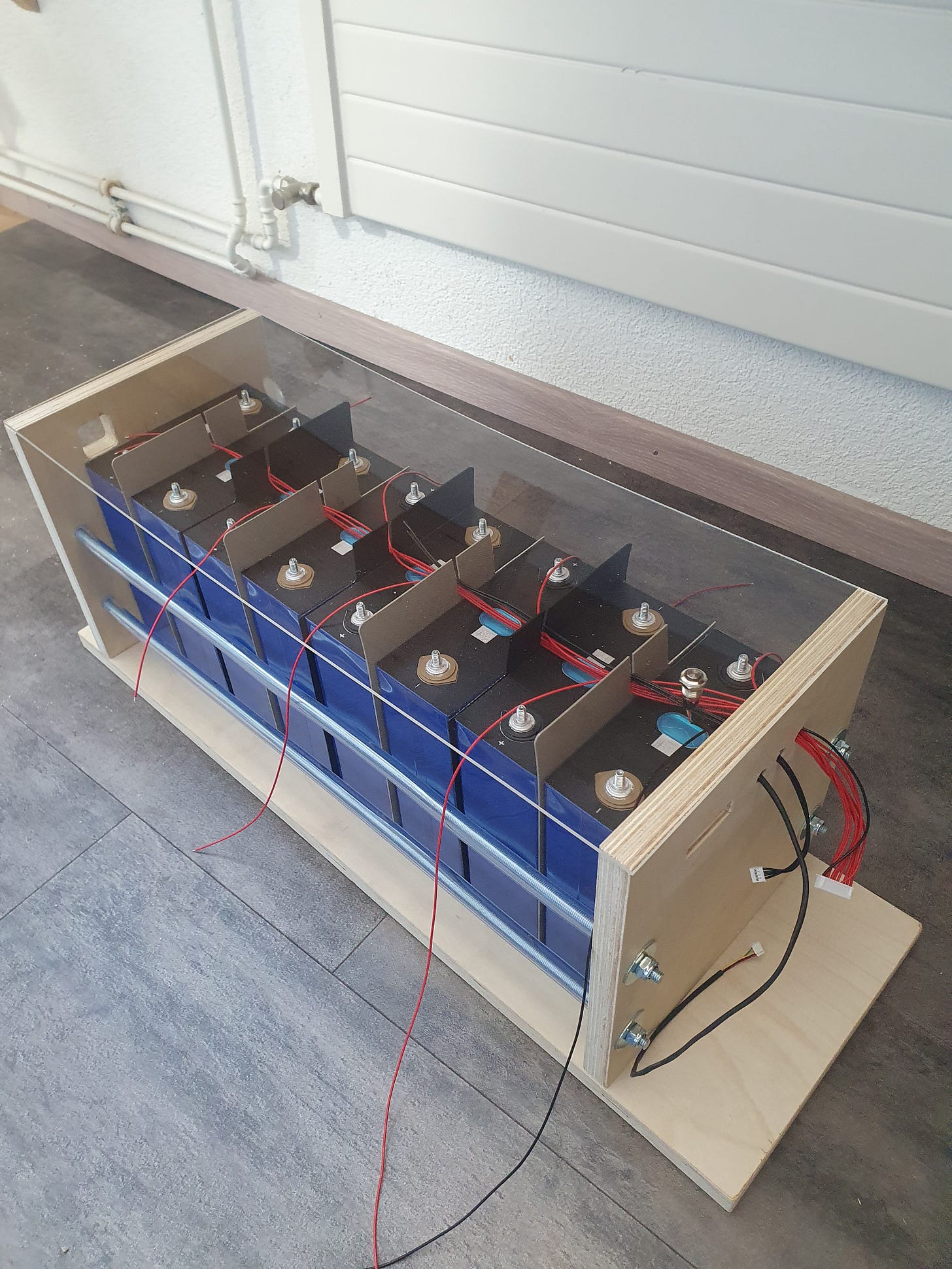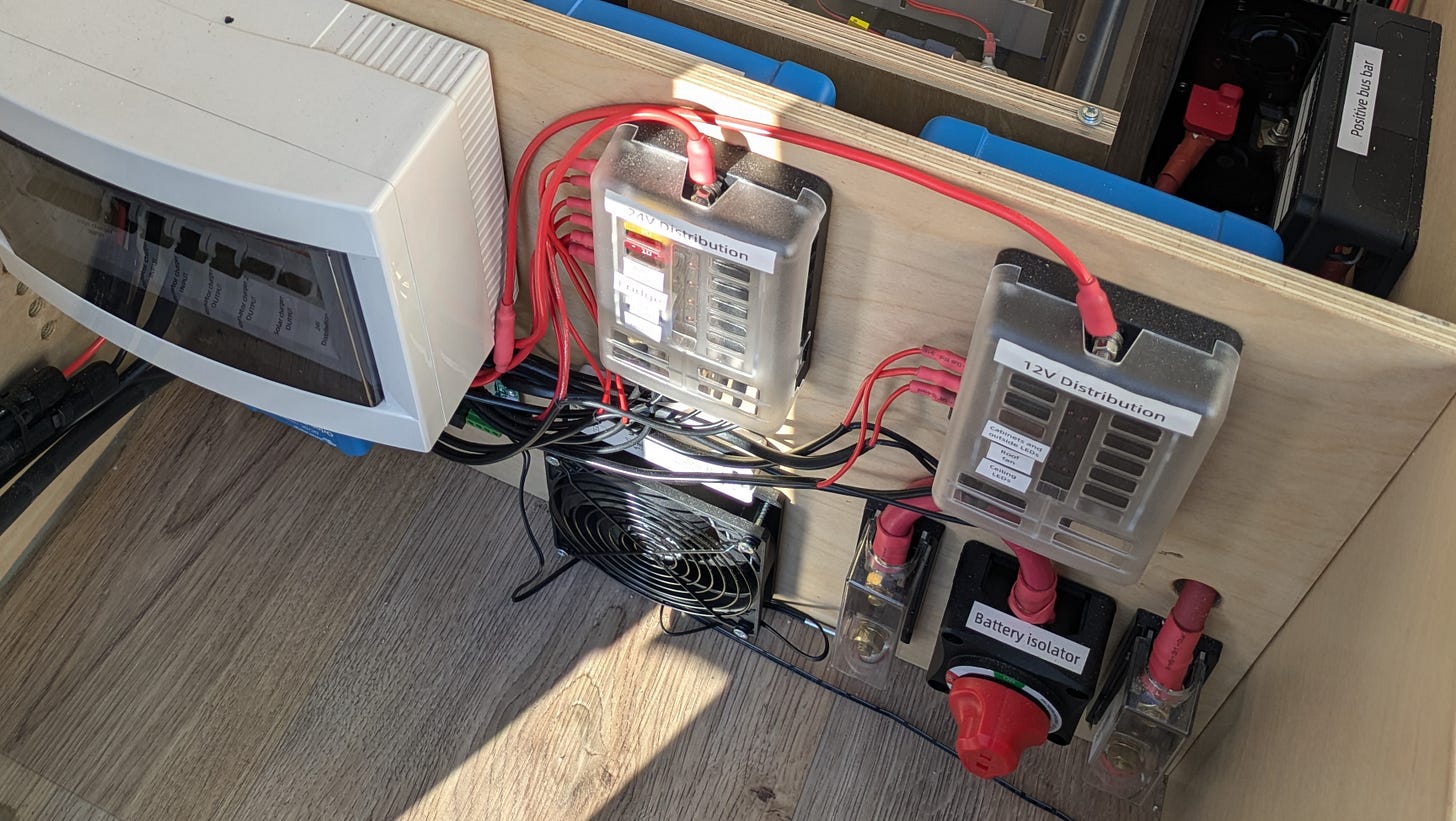Van Tour #01 - The Electrical System
All the specs and numbers from our full electric build. We cook, charge things, heat water, and keep the (literal) lights on using mainly solar energy. Here is how Yuzu's juice flows.
Disclaimer: this is going to be a nerdy tech-heavy post written for people that enjoy engineering and detailed explanations. However, I’ll also try to give a one-line summary of every paragraph for those that have a disappointingly limited interest in the subject.
Overview
The electrical system of our van was pretty much entirely designed around the need to power induction stoves. When cooking at home, you might not realize that heating things with electricity requires a lot of power. Specifically, for our two stoves set-up, we knew we’d require 3kW of continuous power. Add to this lights, fridge, heating, and a few phones charging and you easily get to 3.5kW. A 12V battery, which is quite standard in campers, would have to output 300A of continuous current, and even more during peaks (e.g. when the induction stoves are switched on). This is challenging both for the battery itself and because it requires copper cables with a 120mm2 section, which are heavy and expensive. So, to reduce the high current issue, we opted for a 24V system.
Summary: Cooking needs big electricity, so we got big batteries.Once we knew we wanted 24V and 3.5kW, we started designing the system. Some time during summer 2023 we completed this blueprint

The main challenge in this exercise was to select the correct wire size for each part of the system, so that all currents could be carried safely by the respective conductor, and that each conductor could be protected with a correctly sized fuse. For this, we mostly used this nice calculator. Every cable we used has a minimum temperature rating of 105ºC and resists to solvents and fuel, which is quite important in a vehicle.
Summary: big cable expensive, small cable dangerous.Battery
We bought eight EVE LiFePo4 cells directly from Alibaba. Each cell has a nominal voltage of 3.2V and a minimum capacity of 280Ah. We assembled the cells in series to form a 25.6V lithium battery with a total capacity of 7.2kWh.
“Let’s hope it never explodes” — Xavier
“Well, you built it…” — Lisa
“… let’s hope it never explodes” — Xavier
The cells are being continuously balanced by a battery management system, which ensures that they charge and discharge uniformly. The battery can be discharged at 200A or charged at 140A. Both amounts are significantly larger than our maximum electricity consumption or production, which is ideal.

The battery connects to Yuzu’s grid via a smart shunt unit, which measures the power flowing through it to stream useful values such as the battery’s state of charge directly to our smartphones.
Interesting fact: to optimize space, the battery’s connection to the system happens via two custom-built pieces of copper that we have first shaped and then electroplated with nickel. The plating process was a lot of fun. It might or might not have taken place in a university laboratory during work meetings…
Summary: I like big butts batteries and I cannot lie.Solar system
Here, the limiting factor was the size of the roof. So we measured the roof and then fitted the largest solar modules we could. At the expense of a slightly heavier set-up, we ignored camper-specific solar modules and opted for standard roof modules. They are cheaper, sturdier, and much more efficient. We could fit two modules, and connected them in parallel for a total power of 870W at 57V. The modules are wired to a charge controller that ensures that the lithium batteries are being charged safely and efficiently. The controller receives information about the battery’s voltage and temperature on a local network and adapts accordingly. When the battery is charged, the solar controller can support directly any active load in the van (such as the roof fan or the induction stoves). It also streams the instantaneous power that the solar system is generating to our smartphones. Does knowing it make a difference? No. Do we like data? Yes!
Interesting fact: after not washing Yuzu for almost a full year, our highest solar production had dropped to 350W, which is why we’re going to clean the modules regularly once we hit the road.
Summary: Our roof is covered in solar panels, they make electricty.Alternator chargers
Solar is great when there’s sun. When there’s no sun, we have to burn good old diesel to make electricity. We do this by using the alternator in the engine, which produces 150A at 14V. A significant fraction of this power is used by the van itself, but the rest we can happily steal. We wired two chargers to the engine’s battery. Each can charge the house battery at 15A, for a grand total of 760W.
The alternator chargers also receive an ignition signal from the engine. This is used to make sure that they operate exclusively when the engine is running. Otherwise, they might charge our house battery at the expense of the engine’s battery. The result would be that we can watch Netflix and make hot tea, but can’t turn the engine on anymore.
Summary: We can charge our batteries also when driving.Distribution
So, the batteries are charged. How do we use all this fresh Yuzu juice? We have tried to minimize voltage changes to avoid losses, but some were unavoidable, so electricity is distributed at three different voltages.
Most appliances run on 24V, the battery’s voltage. They are
Fridge (80W)
Water electric heater (450W)
Air heater (ignition only, heat is from diesel combustion) (20W)
USB sockets (2 x 66W)
Water pump (120W)
LEDs in the storage space (45W)
Then, we had to install a 24V to 12V converter, for the appliances that we could only install in 12V. These are
Indoors LEDs (both pucks on the roof and under the overhead cabinets) (6 x 2.5W + 2 x 8W)
Roof ventilation fan (35W)
Automated electrical cabinet cooling (1W)
Outdoors LEDs (10W)
Tires compressor (150W)
Finally, we have a 3kW inverter (delivering up to 6kW for short amounts of time) that boosts the 24V to 230V to power
Induction cooking plates (3kW)
3 standard Swiss sockets for other potential loads (up to 3kW)
Summary: different appliances like different electricities.Conclusion
So far we’re really happy with our electrical system. Everything works so well that we just forget about it, which is exactly how it should be.
Today (a sunny August day in Switzerland) our solar system produced 3.8kWh. It feels good to use solar power in our cozy little home. When we parked, our battery was 100% charged. I am now writing this after having cooked pasta and sauce for two (a 2.9kW load!), cooled beers and groceries, made ice cubes, ventilated the van, and prepared herbal tea, and the battery state of charge has dropped to 95% only. It feels very good.
Summary: We ate pasta. Nothing exploded. We are happy. We’re really happy to hear from you, so be good friends and
If you’re also happy to hear from us, make sure to







I am definitely part of the target audience for the summaries and loved it
thanks for the quick summaries, those are right up my alley!